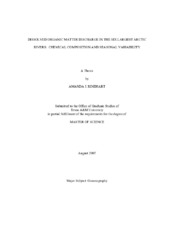| dc.description.abstract | The vulnerability of the Arctic to climate change has been realized due to
disproportionately large increases in surface air temperatures which are not uniformly
distributed over the seasonal cycle. Effects of this temperature shift are widespread in
the Arctic but likely include changes to the hydrological cycle and permafrost thaw,
which have implications for the mobilization of organic carbon into rivers. The focus of
this research was to describe the seasonal variability of the chemical composition of
dissolved organic matter (DOM) in the six largest Arctic rivers (Yukon, Mackenzie, Ob,
Yenisei, Lena and Kolyma) using optical properties (UV-Vis Absorbance and
Fluorescence) and lignin phenol analysis. We also investigated differences between
rivers and how watershed characteristics influence DOM composition.
Dissolved organic carbon (DOC) concentrations followed the hydrograph with
highest concentrations measured during peak river flow. The chemical composition of
peak-flow DOM indicates a dominance of freshly leached material with elevated
aromaticity, larger molecular weight, and elevated lignin yields relative to base-flow
DOM. During peak flow, soils in the watershed are still frozen and snowmelt water
follows a lateral flow path to the river channels. As the soils thaw, surface water
penetrates deeper into the soil horizons leading to lower DOC concentrations and likely
altered composition of DOM due to sorption and microbial degradation processes. The
six rivers studied here shared a similar seasonal pattern and chemical composition.
There were, however, large differences between rivers in terms of total carbon discharge
reflecting the differences in watershed characteristics such as climate, catchment size, river discharge, soil types, and permafrost distribution. The large rivers (Lena, Yenisei),
with a greater proportion of permafrost, exported the greatest amount of carbon. The
Kolyma and Mackenzie exported the smallest amount of carbon annually, however, the
discharge weighted mean DOC concentration was almost 2-fold higher in the Kolyma,
again, indicating the importance of continuous permafrost. The quality and quantity of
DOM mobilized into Arctic rivers appears to depend on the relative importance of
surface run-off and extent of soil percolation. The relative importance of these is
ultimately determined by watershed characteristics. | en |


